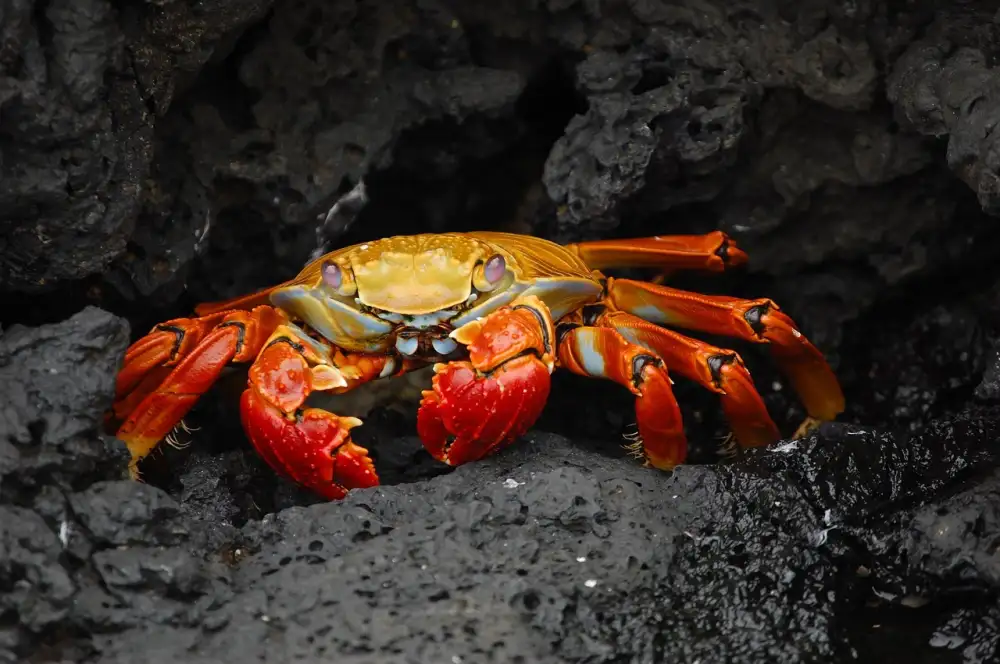Decoding the Delicious Duel: King Crab vs Snow Crab - Which Reigns Supreme?

- Overview of king crab and snow crab
- Importance of comparing the two for seafood enthusiasts
- Appearance and Size
- Description of the physical characteristics of king crab
- Description of the physical characteristics of snow crab
- Comparison of size between the two species
- Flavor and Texture
- Explanation of the flavor profile of king crab
- Explanation of the flavor profile of snow crab
- Comparison of the texture of the meat from both crabs
- Availability and Cost
- Discussion on the availability of king crab
- Discussion on the availability of snow crab
- Comparison of the cost of purchasing both crabs
- Nutritional Value
- Breakdown of the nutritional content of king crab
- Breakdown of the nutritional content of snow crab
- Comparison of the health benefits offered by each crab
- Culinary Uses
- Explanation of popular dishes and recipes featuring king crab
- Explanation of popular dishes and recipes featuring snow crab
- Comparison of the versatility in culinary applications for both crabs
- Sustainability and Environmental Impact
- Discussion on the sustainability of king crab fishing
- Discussion on the sustainability of snow crab fishing
- Comparison of the environmental impact of harvesting both crabs
- Recap of the key differences between king crab and snow crab
- Encouragement for readers to explore and enjoy both varieties
Decoding the Delicious Duel: King Crab vs Snow Crab - Which Reigns Supreme?
When it comes to indulging in the wonders of seafood, few experiences can match the delight of savoring delectable crab meat. Among the many varieties available, king crab and snow crab stand out as true delicacies. In this article, we will delve into the world of these magnificent crustaceans, comparing their attributes and exploring why they are a must-try for all seafood enthusiasts. So buckle up and get ready to embark on a culinary adventure like no other!
Overview of king crab and snow crab
King crab and snow crab are two popular types of seafood that are highly sought after by seafood enthusiasts. King crab, also known as Alaskan king crab or red king crab, is a large and impressive species known for its size and meaty claws. Snow crab, on the other hand, is smaller in size but equally delicious with its delicate and sweet flavor. Comparing these two crabs allows us to appreciate the unique qualities each has to offer and discover which one reigns supreme in the world of culinary delights.
Importance of comparing the two for seafood enthusiasts
Comparing king crab and snow crab is essential for seafood enthusiasts as it allows them to understand the nuances of these two delectable crustaceans. By comparing their appearance, flavor, availability, cost, nutritional value, culinary uses, sustainability, and environmental impact, enthusiasts can make informed choices when selecting and preparing these delicacies. So let's dive into the delicious duel between king crab and snow crab to discover which reigns supreme!
Appearance and Size
King crab is known for its large size and impressive appearance. It has a reddish-brown shell with sharp spines and long, thick legs. The body can reach up to 25 centimeters in width, making it one of the largest crabs in the world. On the other hand, snow crab has a more delicate and intricate look. Its shell is lighter in color, ranging from pale yellow to light brown. Snow crab also has longer legs compared to its body size, giving it a more slender appearance. In terms of size, snow crab is generally smaller than king crab, with an average width of around 15 centimeters.
Description of the physical characteristics of king crab
King crabs are known for their impressive size and striking appearance. They have a robust body covered in a hard exoskeleton that is reddish-brown in color. The most distinguishing feature of king crabs is their long, spindly legs, which can span up to 6 feet in length. These legs are adorned with sharp, pointed spines and end in powerful claws that are used for defense and feeding. The body of a king crab can measure up to 11 inches wide and weigh as much as 20 pounds, making it one of the largest crustaceans in the world. Its formidable size and intimidating appearance make the king crab a true marvel of the sea.
Description of the physical characteristics of snow crab
Snow crabs, also known as opilio crabs or queen crabs, are smaller in size compared to king crabs. They have a rounder and more compact body with long, slender legs. Their shell is a reddish-brown color and is covered in spiky hairs. Snow crabs have a distinctive triangular shape with a pointed head and a wide carapace. The legs of snow crabs are thinner and longer than those of king crabs, making them easier to break open to access the sweet meat inside. Despite their smaller size, snow crabs still offer a delightful culinary experience for seafood enthusiasts.
Comparison of size between the two species
When it comes to size, king crab and snow crab have distinct differences. King crabs are known for their massive size, with some species reaching lengths of up to 6 feet and weighing over 20 pounds. In contrast, snow crabs are relatively smaller, typically measuring around 2-3 feet in length and weighing between 2-4 pounds. Despite their size disparity, both crabs offer a delightful culinary experience that is worth exploring.
Flavor and Texture
When it comes to flavor and texture, king crab and snow crab offer distinct culinary experiences. King crab meat is known for its rich, sweet taste with a hint of brininess. Its firm and succulent texture adds to the overall indulgence. On the other hand, snow crab has a delicate, slightly sweet flavor that is often described as more subtle compared to king crab. The meat of snow crab is tender and flaky, making it a delightful choice for those who prefer a lighter seafood option. Whether you crave bold flavors or prefer a milder taste, both crabs have their unique appeal in terms of flavor and texture.
Explanation of the flavor profile of king crab
The flavor profile of king crab is often described as rich, sweet, and succulent. The meat has a delicate sweetness that is complemented by a hint of brininess. It has a slightly buttery taste and a tender texture that melts in your mouth. The flavor is often compared to lobster, making it a popular choice for seafood lovers seeking a luxurious dining experience.
Explanation of the flavor profile of snow crab
Snow crab, also known as opilio crab, offers a delicate and sweet flavor that is often described as slightly briny. Its meat has a subtle sweetness with hints of buttery undertones. The flavor is milder compared to king crab, making it a popular choice for those who prefer a more subtle taste. Snow crab's flavor pairs well with various seasonings and sauces, allowing it to be incorporated into a wide range of dishes. Whether enjoyed in salads, pasta dishes, or simply steamed and served with melted butter, snow crab's delicate flavor profile never fails to impress seafood enthusiasts.
Comparison of the texture of the meat from both crabs
When it comes to texture, the meat from king crab and snow crab differ in their own unique ways. King crab meat is known for its firm and succulent texture. It has a satisfying bite and holds up well in various cooking methods, making it perfect for dishes like crab cakes or grilled crab legs. On the other hand, snow crab meat has a slightly softer texture. It is delicate and tender, with a melt-in-your-mouth quality that is ideal for dishes like creamy crab bisques or delicate sushi rolls. Both crabs offer delightful textures that can elevate any seafood dish to new heights of deliciousness.
Availability and Cost
When it comes to availability, king crab is considered a delicacy and is typically more difficult to find compared to snow crab. King crab is mainly harvested in the waters of Alaska, making it a specialty item that may not be readily available in all seafood markets. Snow crab, on the other hand, is more widely distributed and can be found in various regions such as the Atlantic Ocean and the Bering Sea.
In terms of cost, king crab tends to be more expensive than snow crab due to its limited availability and high demand. The larger size of king crab also contributes to its higher price tag. Snow crab, although still considered a premium seafood option, is generally more affordable and accessible for consumers.
Both crabs offer unique flavors and textures that are worth exploring, regardless of their availability and cost. So whether you choose the regal king crab or the delicate snow crab, prepare yourself for a delectable culinary experience that will surely satisfy your seafood cravings.
Discussion on the availability of king crab
King crab, also known as Alaskan king crab, is highly sought after for its succulent meat and impressive size. However, due to its popularity and limited fishing seasons, the availability of king crab can be somewhat limited. King crab is primarily harvested in the waters of Alaska, where it thrives in the cold and nutrient-rich environment. The fishing season for king crab typically runs from October to January, with strict regulations in place to ensure sustainable harvesting practices. As a result, fresh king crab may not be readily available year-round, but frozen options are often more accessible. Despite its limited availability, the exquisite taste and texture of king crab make it well worth seeking out for seafood enthusiasts.
Discussion on the availability of snow crab
Snow crab, also known as opilio crab or queen crab, is widely available in North America. It is primarily harvested in the cold waters of the Bering Sea and the Gulf of St. Lawrence. The snow crab season typically runs from late fall to early spring, making it readily accessible during those months. Its popularity has led to increased efforts in sustainable fishing practices to ensure its availability for years to come. Whether enjoyed at a seafood restaurant or purchased from a local fish market, snow crab is a delicious option for seafood lovers looking to indulge in its sweet and delicate meat.
Comparison of the cost of purchasing both crabs
When it comes to cost, king crab tends to be more expensive than snow crab. This is mainly due to the fact that king crab is larger in size and its meat is considered more luxurious. The price of king crab can vary depending on the season and availability, but it is generally higher compared to snow crab. Snow crab, on the other hand, is more affordable and accessible for seafood enthusiasts who are looking for a delicious option without breaking the bank. Whether you choose king crab or snow crab, both options offer a delectable seafood experience worth indulging in.
Nutritional Value
King crab is a rich source of protein, with a 3-ounce serving providing around 19 grams. It is low in fat and calories, making it a healthy choice for those watching their weight. Additionally, king crab is packed with essential minerals such as zinc, selenium, and potassium. Snow crab also offers a good amount of protein, with around 20 grams per 3-ounce serving. It is low in fat and calories as well. Snow crab contains notable amounts of vitamin B12 and phosphorus. Both crabs provide omega-3 fatty acids, which are beneficial for heart health. Overall, both king crab and snow crab offer impressive nutritional profiles that contribute to a well-balanced diet.
Breakdown of the nutritional content of king crab
King crab is not only delicious but also packed with nutrients. A 3-ounce serving of king crab provides approximately 82 calories, 1 gram of fat, and a whopping 16 grams of protein. It is also a good source of vitamins such as vitamin B12, vitamin C, and vitamin E. Additionally, king crab contains essential minerals like zinc, selenium, and copper. With its low calorie and fat content combined with high protein and nutrient levels, king crab is a nutritious choice for seafood lovers.
Breakdown of the nutritional content of snow crab
Snow crab is not only a delicious seafood option but also a nutritious one. It is low in calories, with just 87 calories per 100 grams. Snow crab is an excellent source of protein, providing about 19 grams per serving. It is also rich in vitamins and minerals, including vitamin B12, zinc, selenium, and phosphorus. Additionally, snow crab contains omega-3 fatty acids, which are beneficial for heart health. With its impressive nutritional profile, snow crab offers a tasty way to incorporate essential nutrients into your diet.
Comparison of the health benefits offered by each crab
When it comes to health benefits, both king crab and snow crab offer a range of nutritional value. King crab is known for its high protein content, which helps build and repair tissues in the body. It is also a good source of omega-3 fatty acids, which promote heart health and reduce inflammation. Snow crab, on the other hand, is packed with vitamins such as vitamin B12, which supports nerve function and red blood cell production. It also contains selenium, an antioxidant that boosts immune function. Both crabs are low in saturated fat and calories, making them a healthy choice for seafood lovers.
Culinary Uses
When it comes to culinary uses, both king crab and snow crab offer a wide range of delicious possibilities. King crab is often the star of luxurious dishes such as crab legs served with melted butter or in decadent seafood pasta. Its sweet and rich flavor pairs perfectly with garlic, lemon, and herbs. Snow crab, on the other hand, is known for its delicate and slightly sweet taste. It is commonly used in dishes like crab cakes, salads, and stir-fries. Both crabs can be enjoyed in soups, stews, and even sushi rolls. With their distinct flavors and textures, these crabs are sure to elevate any seafood dish to new heights of culinary delight.
Explanation of popular dishes and recipes featuring king crab
King crab is highly sought after for its sweet and succulent meat, making it a star ingredient in many popular dishes. One of the most iconic preparations is the classic King Crab Legs, where the meat is simply steamed or boiled and served with melted butter. Another favorite is King Crab Bisque, a rich and creamy soup that showcases the crab's natural flavors. For those looking for something more indulgent, King Crab Mac and Cheese or King Crab Stuffed Mushrooms are sure to satisfy. Whether enjoyed on its own or incorporated into a variety of recipes, king crab never fails to impress with its exquisite taste and versatility.
Explanation of popular dishes and recipes featuring snow crab
Snow crab is a versatile ingredient that can be used in a variety of delicious dishes. One popular way to enjoy snow crab is by simply steaming or boiling the legs and serving them with melted butter for dipping. The sweet and delicate flavor of the snow crab meat pairs perfectly with the rich and creamy butter.
Another popular dish featuring snow crab is crab cakes. The tender snow crab meat is mixed with breadcrumbs, mayonnaise, herbs, and spices, then formed into patties and fried until golden brown. These crispy and flavorful crab cakes are often served with a tangy tartar sauce or a zesty remoulade.
Snow crab also shines in pasta dishes. The sweet and succulent meat can be tossed with linguine or spaghetti, along with garlic, olive oil, lemon juice, and fresh herbs for a light and refreshing seafood pasta. Alternatively, it can be incorporated into creamy Alfredo or rich tomato-based sauces for a more indulgent treat.
For those who enjoy sushi, snow crab is commonly used as a filling in sushi rolls. Its mild flavor complements other ingredients such as avocado, cucumber, and spicy mayo. Snow crab sushi rolls are often topped with tobiko (flying fish roe) for an added burst of flavor and texture.
Whether enjoyed on its own or incorporated into various dishes, snow crab offers seafood enthusiasts an array of culinary possibilities to explore and savor.
Comparison of the versatility in culinary applications for both crabs
Both king crab and snow crab offer a wide range of culinary possibilities. King crab is often celebrated for its succulent meat, which is perfect for indulgent dishes like crab legs with melted butter or creamy crab bisque. Its sweet and rich flavor also pairs well with citrus and herbs, making it a popular choice for salads and pasta dishes.
On the other hand, snow crab has a slightly milder taste that lends itself well to delicate flavors. Its tender meat is often used in sushi rolls, seafood salads, and stir-fries. Snow crab can also be incorporated into creamy dips or used as a topping for pizzas and tacos.
While king crab tends to steal the spotlight in upscale seafood restaurants, snow crab's versatility makes it a favorite among home cooks who appreciate its affordability and ease of preparation. Whether you're looking to impress guests with an extravagant feast or whip up a quick weeknight dinner, both crabs offer endless culinary possibilities that are sure to delight your taste buds.
Sustainability and Environmental Impact
7. Sustainability and Environmental Impact
When it comes to sustainability, both king crab and snow crab fishing have their own challenges. King crab populations have been heavily impacted by overfishing in the past, leading to strict regulations on harvesting. However, efforts are being made to rebuild these populations through careful management and conservation measures.
On the other hand, snow crab fishing is generally considered more sustainable due to its shorter lifespan and faster reproductive rate. This allows for a quicker recovery of stocks compared to king crab. Additionally, snow crab fishing methods often involve using traps or pots which minimize bycatch and damage to the ocean floor.
Despite these efforts, both types of crab fishing can still have negative environmental impacts. The use of large-scale fishing gear can inadvertently catch non-target species, disrupting the balance of marine ecosystems. Furthermore, the extraction of crabs from their natural habitat can alter food chains and affect other marine organisms.
To mitigate these concerns, it is crucial for seafood enthusiasts to support sustainable fishing practices by choosing certified sources and advocating for responsible harvesting methods. By doing so, we can ensure that future generations will continue to enjoy the culinary wonders offered by both king crab and snow crab while preserving our oceans' delicate ecosystems.
Discussion on the sustainability of king crab fishing
King crab fishing is a complex issue when it comes to sustainability. The demand for king crab has led to overfishing in some regions, causing concerns about the long-term viability of the species. However, efforts have been made to regulate and manage king crab fisheries through quotas and strict harvesting guidelines. These measures aim to protect the population and ensure its sustainability for future generations. It is crucial for consumers to support sustainable fishing practices by choosing responsibly sourced king crab.
Discussion on the sustainability of snow crab fishing
Snow crab fishing is generally considered to be more sustainable compared to king crab fishing. This is mainly due to the fact that snow crabs have a shorter lifespan and reproduce at a faster rate. Additionally, snow crabs are typically found in colder waters, which helps protect their population from overfishing. However, it is still important for fisheries to implement proper management practices to ensure the long-term sustainability of snow crab populations. By adhering to regulations and quotas, fishermen can help maintain a healthy balance between harvesting snow crabs and preserving their habitat for future generations.
Comparison of the environmental impact of harvesting both crabs
When it comes to the environmental impact of harvesting king crab and snow crab, there are some key differences to consider. King crab fishing is known to have a higher environmental impact due to the use of large, heavy traps that can damage the seafloor and other marine habitats. Additionally, the bycatch in king crab fisheries can be significant, with unintended capture of other species such as fish and sea birds.
On the other hand, snow crab fishing has a lower environmental impact compared to king crab fishing. Snow crabs are usually caught using smaller traps or pots, which cause less damage to the seafloor. The bycatch in snow crab fisheries is also relatively low, reducing the overall impact on non-targeted species.
It's important for seafood enthusiasts to be aware of these environmental considerations when making their choices. Opting for sustainably sourced king crab and snow crab can help support responsible fishing practices and protect our oceans for future generations to enjoy.
In conclusion, both king crab and snow crab have their own unique qualities that make them a delight for seafood enthusiasts. King crab is known for its large size and rich flavor, while snow crab offers a delicate taste and tender texture. In terms of availability, king crab can be more limited and expensive compared to snow crab. However, both crabs offer a range of health benefits and can be used in various culinary creations. It's important to consider the sustainability and environmental impact of harvesting these crabs as well. So why choose one when you can explore and enjoy the best of both worlds?
Recap of the key differences between king crab and snow crab
In conclusion, it is clear that king crab and snow crab have distinct differences that set them apart. King crab boasts larger size and a more robust flavor profile, while snow crab offers a delicate sweetness. King crab is generally more expensive and less readily available compared to snow crab. In terms of nutrition, both crabs offer valuable health benefits. Culinary-wise, king crab is often featured in decadent dishes like crab legs and bisques, while snow crab is popular in salads and sushi rolls. Lastly, sustainability efforts are crucial for both species to ensure their long-term survival. So why choose one when you can indulge in the best of both worlds? Explore the delicious possibilities of king crab and snow crab today!
Encouragement for readers to explore and enjoy both varieties
In conclusion, both king crab and snow crab offer unique and delightful culinary experiences. While they may differ in appearance, flavor, availability, cost, nutritional value, and sustainability, they are equally deserving of our attention and appreciation. Seafood enthusiasts should embrace the opportunity to explore and enjoy both varieties, as each brings its own distinct qualities to the table. So go ahead, indulge in the delicious duel between king crab and snow crab - you won't be disappointed!
Published: 20. 11. 2023
Category: Food



